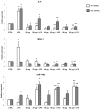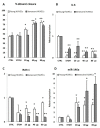Antioxidant and Anti-Inflammaging Ability of Prune (Prunus Spinosa L.) Extract Result in Improved Wound Healing Efficacy
- PMID: 33801467
- PMCID: PMC7999414
- DOI: 10.3390/antiox10030374
Antioxidant and Anti-Inflammaging Ability of Prune (Prunus Spinosa L.) Extract Result in Improved Wound Healing Efficacy
Abstract
Prunus spinosa L. fruit (PSF) ethanol extract, showing a peculiar content of biologically active molecules (polyphenols), was investigated for its wound healing capacity, a typical feature that declines during aging and is negatively affected by the persistence of inflammation and oxidative stress. To this aim, first, PSF anti-inflammatory properties were tested on young and senescent LPS-treated human umbilical vein endothelial cells (HUVECs). As a result, PSF treatment increased miR-146a and decreased IRAK-1 and IL-6 expression levels. In addition, the PSF antioxidant effect was validated in vitro with DPPH assay and confirmed by in vivo treatments in C. elegans. Our findings showed beneficial effects on worms' lifespan and healthspan with positive outcomes on longevity markers (i.e., miR-124 upregulation and miR-39 downregulation) as well. The PSF effect on wound healing was tested using the same cells and experimental conditions employed to investigate PSF antioxidant and anti-inflammaging ability. PSF treatment resulted in a significant improvement of wound healing closure (ca. 70%), through cell migration, both in young and older cells, associated to a downregulation of inflammation markers. In conclusion, PSF extract antioxidant and anti-inflammaging abilities result in improved wound healing capacity, thus suggesting that PSF might be helpful to improve the quality of life for its beneficial health effects.
Keywords: C. elegans; HUVEC; MicroRNA; aging phenotype; biological aging; cell migration; lifespan; polyphenols; tissue regeneration.
Conflict of interest statement
The authors declare no conflict of interest.
Figures








Similar articles
-
Prunus spinosa Extract Loaded in Biomimetic Nanoparticles Evokes In Vitro Anti-Inflammatory and Wound Healing Activities.Nanomaterials (Basel). 2020 Dec 25;11(1):36. doi: 10.3390/nano11010036. Nanomaterials (Basel). 2020. PMID: 33375632 Free PMC article.
-
Wild Italian Prunus spinosa L. Fruit Exerts In Vitro Antimicrobial Activity and Protects Against In Vitro and In Vivo Oxidative Stress.Foods. 2019 Dec 19;9(1):5. doi: 10.3390/foods9010005. Foods. 2019. PMID: 31861742 Free PMC article.
-
Anti-inflammatory effect of ubiquinol-10 on young and senescent endothelial cells via miR-146a modulation.Free Radic Biol Med. 2013 Oct;63:410-20. doi: 10.1016/j.freeradbiomed.2013.05.033. Epub 2013 May 30. Free Radic Biol Med. 2013. PMID: 23727324
-
Mitochondrial (Dys) Function in Inflammaging: Do MitomiRs Influence the Energetic, Oxidative, and Inflammatory Status of Senescent Cells?Mediators Inflamm. 2017;2017:2309034. doi: 10.1155/2017/2309034. Epub 2017 Dec 27. Mediators Inflamm. 2017. PMID: 29445253 Free PMC article. Review.
-
Anti-inflammatory and wound healing potential of cashew apple juice (Anacardium occidentale L.) in mice.Exp Biol Med (Maywood). 2015 Dec;240(12):1648-55. doi: 10.1177/1535370215576299. Epub 2015 Mar 27. Exp Biol Med (Maywood). 2015. PMID: 25819683 Free PMC article. Review.
Cited by
-
Crataegus monogyna Jacq., Sorbus aria (L.) Crantz and Prunus spinosa L.: From Edible Fruits to Functional Ingredients: A Review.Foods. 2025 Jun 28;14(13):2299. doi: 10.3390/foods14132299. Foods. 2025. PMID: 40647052 Free PMC article. Review.
-
Remnants from the Past: From an 18th Century Manuscript to 21st Century Ethnobotany in Valle Imagna (Bergamo, Italy).Plants (Basel). 2023 Jul 24;12(14):2748. doi: 10.3390/plants12142748. Plants (Basel). 2023. PMID: 37514363 Free PMC article.
-
A hypothesis: MiRNA-124 mediated regulation of sirtuin 1 and vitamin D receptor gene expression accelerates aging.Aging Med (Milton). 2024 Jun 15;7(3):320-327. doi: 10.1002/agm2.12330. eCollection 2024 Jun. Aging Med (Milton). 2024. PMID: 38975301 Free PMC article.
-
A Biomaterial Model to Assess the Effects of Age in Vascularization.Cells Tissues Organs. 2023;212(1):74-83. doi: 10.1159/000523859. Epub 2022 Mar 4. Cells Tissues Organs. 2023. PMID: 35249009 Free PMC article.
-
Blackthorn-A Valuable Source of Phenolic Antioxidants with Potential Health Benefits.Molecules. 2023 Apr 14;28(8):3456. doi: 10.3390/molecules28083456. Molecules. 2023. PMID: 37110690 Free PMC article. Review.
References
-
- Tiboni M., Coppari S., Casettari L., Guescini M., Colomba M., Fraternale D., Gorassini A., Verardo G., Ramakrishna S., Guidi L., et al. Prunus spinosa Extract Loaded in Biomimetic Nanoparticles Evokes In Vitro Anti-Inflammatory and Wound Healing Activities. Nanomaterials. 2020;11:36. doi: 10.3390/nano11010036. - DOI - PMC - PubMed
-
- Olivieri F., Lazzarini R., Recchioni R., Marcheselli F., Rippo M.R., Di Nuzzo S., Albertini M.C., Graciotti L., Babini L., Mariotti S., et al. MiR-146a as marker of senescence-associated pro-inflammatory status in cells involved in vascular remodelling. Age (Omaha) 2013;35:1157–1172. doi: 10.1007/s11357-012-9440-8. - DOI - PMC - PubMed
-
- Nour V., Trandafir I., Cosmulescu S. Bioactive compounds, antioxidant activity and nutritional quality of different culinary aromatic herbs. Not. Bot. Horti Agrobot. Cluj-Napoca. 2017;45:179–184. doi: 10.15835/nbha45110678. - DOI
Grants and funding
LinkOut - more resources
Full Text Sources
Other Literature Sources
Research Materials

